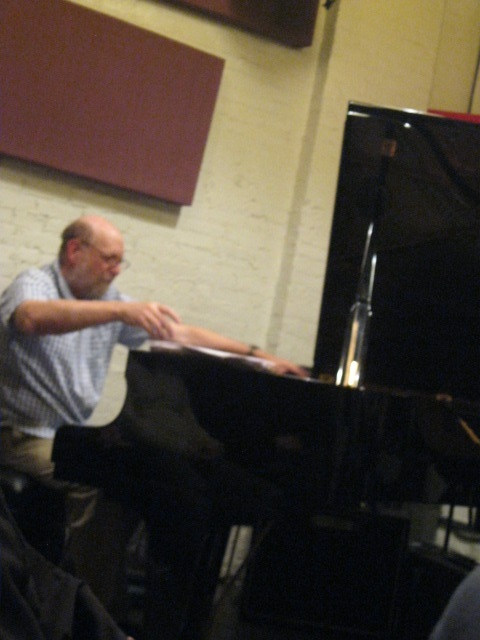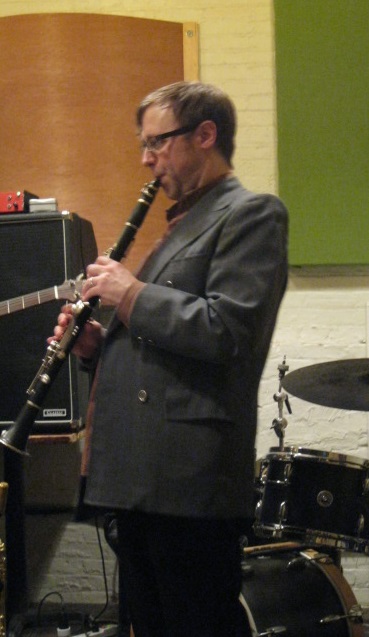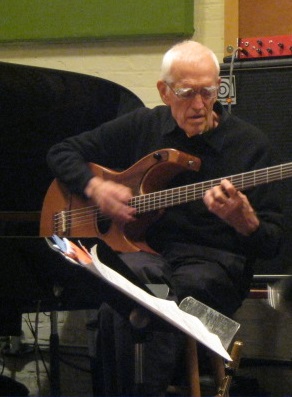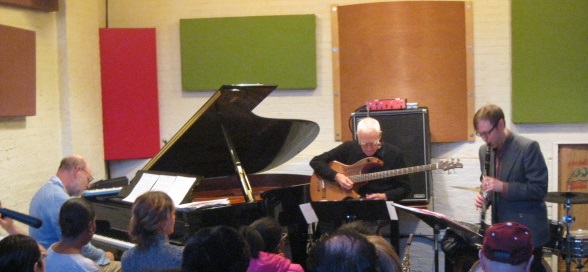Chances to hear pianist Art Lande in action in New York City are rare; with bassist Steve Swallow, even rarer (they had a band in the Bay Area in the '70s). Fortunately for New Yorkers, clarinetist/soprano saxophonist Mike McGinnis took it upon himself to bring them together for some trio concerts, and though snow in Colorado kept Lande from arriving for the originally scheduled Thursday and Friday shows, IBeam was able to accommodate them for the expected four sets by squeezing in a late set Saturday and then three sets Sunday night; I caught the first two on Sunday.

In both the sets I heard, a new Lande composition, "Shanty Cruise," was featured, both times with a snippet of a traditional sea shanty sung as a lead-in. In this set it was "Drunken Sailor," which Lande prompted a friend in the audience to sing; next time around, Lande himself sang "Blow the Man Down." "Shanty Cruise" alternated swathes of circle-of-fifths harmonic movement with sideways-by-steps progressions. Its lead sheet is one page, and the piece circled around a lot, yet with these players, it never seemed redundant. McGinnis switched to soprano sax for this tune, and the combination of the melody's repeated notes and his soprano tone reminded me of Jan Garbarek, though perhaps it's Lande's 1974 ECM album with Garbarek, Red Lanta, that put that thought in my head.
The most striking composition in this set was Lande's "For Elise," inspired by a stillborn baby. With its odd harmonic juxtapositions, it was a sort of surreal lullaby, one moment soothing, the next slipping into discomfiting unease. Lande's penchant for unusual harmonic progressions was displayed on the following "Shining Life," a tribute to his students' promise that also functioned as a quick-moving contrast to "For Elise." It oscillated between passages of mostly two chords and circles of fifths, embodying a sense of upward progress. Lande switched to melodica for the final section. There was another switch in store on Swallow's "Here Comes Everybody;" after a boppish piano solo that somewhat suggested a Bud Powell influence, Lande walked across the stage and sat behind the drum kit, playing with brushes, before returning to the piano. It was another example of his constant drive to keep timbres and textures varied. Another new Lande tune, "Constantinople," was also boppish, and very forward-driving. I especially enjoyed a section where Swallow soloed over a set pattern played by Lande and McGinnis that suggested a stripped-down version of the head.


McGinnis had asked Lande for an arrangement of the standard "Darn That Dream"; Lande obliged with what he termed "a derangement," "another dream, this one turns into a nightmare." The standard's melody eventually arrived after an intro. At times the meter seemed to be 5/4, but never for long; this enhanced the dream-like nature of the arrangement. Lande sang along with/against McGinnis's wildly fluttering solo, which shifted gears into a more normal extrapolation from the standard, then a disjointed loping, and then back into nightmarish scurrying; there seemed to be a rondo-like form underlying it all. Lande also soloed, accompanied by Swallow, before the trio reunited for the conclusion.

Lande insisted on a free improvisation, which he kicked off with a lengthy stretch of verbal free association before devoting his attention to piano and melodica. McGinnis, on clarinet, fit in just as well with the masters in the boundaryless format as he had in their tricky tonalities. Swallow explained that the next piece, "Bite Your Grandmother," was inspired by March King John Phillip Sousa's reaction to early jazz. It was (Thelonious) Monk-ish in tone, especially Lande's playing; with McGinnis on soprano sax, Steve Lacy came to mind. Lande hopped back on drums and this time revealed more technical skill as he moved from brushes to sticks for more assertive playing. Swallow spent much of the tune "walking" with such supple grace that at times it seemed like a gracefully restrained guitar lead. A section of trading fours showed even more drum technique on Lande's part.
As the head returned (and the set came to a close), I found myself thinking it was as though "Evidence" had been expanded. Yet here, and through out the two sets, while jazz's past was sometimes referenced, the overwhelming impression and impact was of highly distinctive players creating something quite fresh, always protean and shifting, always full of the sense of surprise that is the epitome of pure jazz.
Photos by the author.

